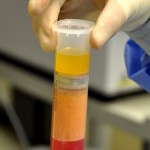Fat appears to be a near ideal material for facial volume restoration or augmentation. Known as lipofilling, it is a very safe and relatively inexpensive method of adding volume to either the aging or lipodystrophic face. While injecting fat into the face is straightforward, the important question becomes how to ensure that most of it will survive. Post-injection resorption is a well known problem with fat injections. There are undoubtably many factors that influence survival, but one of the most obvious is its preparation prior to injection.
Despite many espoused methods of fat preparation, which all boil down to how it is processed, no ideal method has yet been proven. The most commonly used methods include either filtration/washing and centrifugation of the fat. Filtration is done through a fine mesh screen which is washed with saline prior to placement into a syringe. Centrifugation is a more sophisticated method of machine separation which appears more effective at isolating pure fat. It is the basis of ‘structural fat grafting’. Is one way really better than the other?


Despite arguments that can be made on both sides, the ideal method for fat preparation remains yet unknown. This is also conflicted by the likely fact that the survival of fat cells depends on many other factors as well including the anatomic source of the fat, its method of harvest and the qualities of the recipient bed into which it is implanted. Since there is no way to control all of these variables, we are unlikely to know anytime soon how to best inject fat. For now, I will continue to use filtered/washed preparation method for facial fat injections as it offers the shortest time between harvest and implantation.
Dr. Barry Eppley
Indianapolis, Indiana


